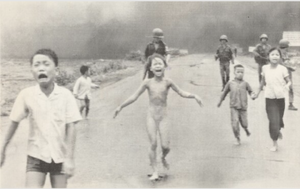Template:MainPageCaseDescription: Difference between revisions
NCACintern (talk | contribs) No edit summary |
NCACintern (talk | contribs) No edit summary |
||
| Line 4: | Line 4: | ||
{{Display censorship incident | {{Display censorship incident | ||
|ongoing=no | |ongoing=no | ||
|year= | |year=2016 | ||
|region= | |region=Asia | ||
|artist= | |artist=Huỳnh Công (Nick) Út | ||
|confronting_bodies=Facebook | |||
|confronting_bodies= | |medium=Electronic Media, Internet, Photography | ||
|medium=Electronic Media, | |date_of_action=September 2016 | ||
|date_of_action= | |||
|location=Online | |location=Online | ||
|description_of_content= | |description_of_content=On June 8, 1972, while serving as a photographer with the Associated Press, Huỳnh Công Út — who works under the professional name Nick Ut — took "The Terror of War," an infamous photo of nine-year-old Kim Phúc running away from a napalm attack during the Vietnam War. | ||
| | |description_of_incident=In early September 2016, Norwegian Prime Minister Erna Solberg denounced Facebook for engaging in censorship after the company deleted a post from her personal Facebook page that displayed Ut's iconic Vietnam War photo of a naked girl running screaming from a napalm attack. | ||
|image= | "While we recognize that this photo is iconic, it's difficult to create a distinction between allowing a photograph of a nude child in one instance and not others," said a Facebook statement addressing the issue. | ||
|source=https:// | |description_of_result=Following widespread criticisms from news organizations and media experts across the globe, Facebook reversed its initial decision, saying in a statement to the Guardian: “After hearing from our community, we looked again at how our Community Standards were applied in this case. An image of a naked child would normally be presumed to violate our Community Standards, and in some countries might even qualify as child pornography. In this case, we recognize the history and global importance of this image in documenting a particular moment in time.” | ||
The statement continued: “Because of its status as an iconic image of historical importance, the value of permitting sharing outweighs the value of protecting the community by removal, so we have decided to reinstate the image on Facebook where we are aware it has been removed.” | |||
Facebook also said it would “adjust our review mechanisms to permit sharing of the image going forward”. The company said the image would be available for sharing “in the coming days” and that it is “always looking to improve our policies to make sure they both promote free expression and keep our community safe”. | |||
|image=Screen Shot 2023-07-27 at 12.09.42 PM.png | |||
|source=https://www.washingtonpost.com/news/the-intersect/wp/2016/09/09/abusing-your-power-mark-zuckerberg-slammed-after-facebook-censors-vietnam-war-photo/, https://www.wsj.com/articles/norway-accuses-facebook-of-censorship-over-deleted-photo-of-napalm-girl-1473428032, https://www.bbc.com/news/technology-37318031, https://www.theguardian.com/technology/2016/sep/09/facebook-reinstates-napalm-girl-photo, https://www.nbcnews.com/tech/social-media/facebook-under-fire-censoring-iconic-napalm-girl-photo-n645526 | |||
}} | }} | ||
</onlyinclude> | </onlyinclude> | ||
Revision as of 14:30, 14 August 2023
Please add the case description between the two tags. The content (description) shown below will be shown on Main Page.
Artist: Huỳnh Công (Nick) Út
Year: 2016
Date of Action: September 2016
Region: Asia
Location: Online
Subject:
Medium: Electronic Media, Internet, Photography
Confronting Bodies: Facebook
Description of Artwork: On June 8, 1972, while serving as a photographer with the Associated Press, Huỳnh Công Út — who works under the professional name Nick Ut — took "The Terror of War," an infamous photo of nine-year-old Kim Phúc running away from a napalm attack during the Vietnam War.
The Incident: In early September 2016, Norwegian Prime Minister Erna Solberg denounced Facebook for engaging in censorship after the company deleted a post from her personal Facebook page that displayed Ut's iconic Vietnam War photo of a naked girl running screaming from a napalm attack.
"While we recognize that this photo is iconic, it's difficult to create a distinction between allowing a photograph of a nude child in one instance and not others," said a Facebook statement addressing the issue.
Results of Incident: Following widespread criticisms from news organizations and media experts across the globe, Facebook reversed its initial decision, saying in a statement to the Guardian: “After hearing from our community, we looked again at how our Community Standards were applied in this case. An image of a naked child would normally be presumed to violate our Community Standards, and in some countries might even qualify as child pornography. In this case, we recognize the history and global importance of this image in documenting a particular moment in time.”
The statement continued: “Because of its status as an iconic image of historical importance, the value of permitting sharing outweighs the value of protecting the community by removal, so we have decided to reinstate the image on Facebook where we are aware it has been removed.”
Facebook also said it would “adjust our review mechanisms to permit sharing of the image going forward”. The company said the image would be available for sharing “in the coming days” and that it is “always looking to improve our policies to make sure they both promote free expression and keep our community safe”.
Source:
• https://www.washingtonpost.com/news/the-intersect/wp/2016/09/09/abusing-your-power-mark-zuckerberg-slammed-after-facebook-censors-vietnam-war-photo/,
• https://www.wsj.com/articles/norway-accuses-facebook-of-censorship-over-deleted-photo-of-napalm-girl-1473428032,
• https://www.bbc.com/news/technology-37318031,
• https://www.theguardian.com/technology/2016/sep/09/facebook-reinstates-napalm-girl-photo,
• https://www.nbcnews.com/tech/social-media/facebook-under-fire-censoring-iconic-napalm-girl-photo-n645526
